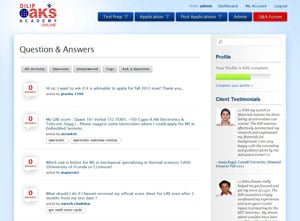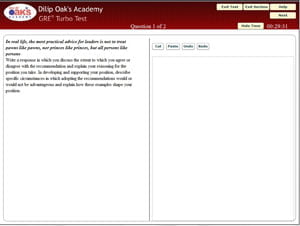Announcing the ‘Best Online Tool for Applying for an MS in the US’!
Here’s some terrific news for all of you who are applying for admission to US universities” – Dilip Oak’s Online, a fantastic resource launched by Dilip Oak’s Academy puts vital help at your fingertips.
Here’s a peek at what makes it so cool:
- US University Information and Document Checklist Feature – an invaluable list of the departments and courses available in the top 220 universities; included is a checklist to help you keep track of which application documents you have or need – get a check list for every university you apply to. This is a treasure trove of information all conveniently collected in one place! (Read more below)
- Question & Answer Forum – a community of advisers that you can turn to and clarify all your doubts relating to the admissions process for American universities (Read more below).
- Application Tracker – a handy app that allows you to monitor the status of your applications (going to apply, applied, admitted…) for every university – view the status of all universities on one convenient page (Read more below).
- Full-length Online GRE Practice Tests in the Revised Pattern – 4 are already available!
- Dilip Oak’s Blog – important news, advice and updates on standardized tests and student meets along with inputs from our past students and professionals in various fields – right on this site!
More exciting features are also coming soon:
- Online Admission Center Services – expert personalized guidance for every aspect of the admission process (Read more below)
- Visa Tips – help to tackle the last and most important obstacle – the visa interview! (Read more below)
1. US University Information Feature
Can’t find information about US Universities? It’s available – in the DOA Online site!

Cut your university research time in half by, selecting a university and looking up the departments, the programs available and the check lists for the top 220 universities. Why go to 220 different websites when you can simply sign up and get all the information here?
And if you find it difficult to keep track of which documents you have for which universities and which ones you don’t, the document checklists for each university will help you to see whether your set of application documents for every university is complete or not.
Also, get deadlines for every university.
2. Question & Answer Forum
Do you have doubts about US universities and admissions? Find out what you need to know right here.

Our Q & A forum allows you to link in to a community of advisers who will guide you on all admissions-related issues – courses, universities, documents and deadlines and so on. Sign up, post questions and cut the confusion. This resource is what you need to get clarity.
3. Application Tracker
Is it difficult to keep which universities you are applying for and which ones you are not? You’ll find our University Applications Tracker so helpful. With it you can see exactly what stage you are at for all the universities you have selected.
![]() The Applications Tracker will help your application efforts get organized.
The Applications Tracker will help your application efforts get organized.
4. Full-length Online GRE Practice Tests in the Revised Pattern
Need good online practice for the GRE Test? Full-Length revised pattern mock GRE tests are just a click away.
Features:
- full-length revised pattern tests – with essay section
- detailed explanations for all questions
- personalized feedback on your essays
- scores on the new scales
 With the Oak’s Online GRE Tests you can prepare to be successful!
With the Oak’s Online GRE Tests you can prepare to be successful!
1. Online Admission Center Services
Does getting admission to a US university seem like a difficult task? Let the experts help.
So far, Dilip Oak’s Admission Center has helped 17,000 students to get admission to good US universities. With 15 years of experience in the field, we can guide you through the complex year-long process to the right university for you. Benefit from our expertise. It will give you a valuable edge as you prepare SOPs, transcripts, financial documents and in every aspect of application process. We are your one-stop shop for admission to US universities
2. Visa Tips
Worried about the Visa Interview? We’ll Help You Prepare
Being well prepared for the dreaded visa interview makes a big difference. We have years of experience in helping students get ready for the visa interview. We’ll help make the process smoother for you.
- We’ll tell you the questions
- We’ll help you frame convincing answers
- We’ll help you prepare flawless documentation
- We’ll take you through a mock interview
With our help you can have the confidence that comes with good preparation
 A college loan covers cost of tuition, living costs and insurance, flight costs, and other incidentals. Given the wide variety of choices available today, by putting in some effort, it is possible to find the best deal for your needs. Taking an education loan is also a smart move as you don’t need to break your savings and you get hefty tax benefits.
A college loan covers cost of tuition, living costs and insurance, flight costs, and other incidentals. Given the wide variety of choices available today, by putting in some effort, it is possible to find the best deal for your needs. Taking an education loan is also a smart move as you don’t need to break your savings and you get hefty tax benefits.
Who should take a loan and why
All students pursuing higher education should take a loan for funding their education. This includes people who already have sufficient funds, i.e. those who have either saved substantially or have considerable backing from family or guardians because, Indian taxation laws allow for a favorable benefit of tax deduction for the repayment of the loans. A total of up to Rs 40,000 is allowed as annual deduction from taxable income under Sec 80E of the IT Act.
Eligibility
Students pursuing full time higher education, in graduate, or post graduate studies, professional education, pure and applied science courses are allowed to claim this deduction. This includes students pursuing overseas education. Most lenders require that students show proof of admission to the graduate or PG program; however, there are some institutions like CREDILA who allow you to secure a loan before securing admission. There are no minimum or maximum age restrictions, although students are usually above 16 years of age or have completed at least the 10th or 12th grade.
How much loan can you get & when and how do you repay?
 Students going abroad can get a loan for up to Rs 20 lakhs from banks and Rs 25-30 lakhs from financial institutions like CREDILA. There are slight variations in regard to application process, documentation, interest rates, guarantees etc. Loan repayments begin one year after the end of your course or six months after you secure your first job, whichever is earlier. Most lenders also allow for additional time for course completion in case the student is not able to finish the course on schedule. Loan repayments are spread over 5-7 years, and include options for closing early.
Students going abroad can get a loan for up to Rs 20 lakhs from banks and Rs 25-30 lakhs from financial institutions like CREDILA. There are slight variations in regard to application process, documentation, interest rates, guarantees etc. Loan repayments begin one year after the end of your course or six months after you secure your first job, whichever is earlier. Most lenders also allow for additional time for course completion in case the student is not able to finish the course on schedule. Loan repayments are spread over 5-7 years, and include options for closing early.
Interest, margin money, guarantors & collateral
- As with all loans, borrowers need to repay the principal (actual amount borrowed) with interest, which is a price you pay for usage of the loan facility. This is a floating percentage, which may be revised as per RBI guidelines and at the lender’s own discretion. For educational loans, the interest rates are in the range of 11-14% for most Nationalised banks and financial institutions. Girls generally get a 0.5% concession. Click here, to see a quick summary.
- There is also the all important factor of “margin money”! What this means is that most lenders will not loan you the entire cost of education – they also expect you to pay part of it. In other words if, for example, your education costs are Rs. 10 lakh in all, and there is a margin of 15%, then, the bank will lend you Rs. 8.5 lakh, and you will have to put up the remaining Rs 1.5 lakhs. The idea is to ensure that the loan seeker has the ability to bring money in and demonstrates responsibility in doing so. This gives some assurance that the borrower will make sure that it is used wisely. Not all lending institutions insist on the margin money, for example, loans taken from HDFC’s dedicated educational loan provider CREDILA, does not need a margin.
- A guarantor is a third party (different from the applicant), who agrees to undertake responsibility for the repayment of the loan in case the original borrower is unable to repay it. Besides this undertaking, lenders generally also ask for collateral in the form of fixed deposit receipts, residential or other property deeds, or other security, which is then kept in the lender’s possession until the loan is repaid. This is done to safeguard the bank or lender against a bad debt. The lender may waive the guarantee if the borrower’s previous repayment track record or financial history is very sound. Typically, loans up to Rs 4 lakh need neither collaterals nor margin money. Besides, students securing a scholarship could have the margin waived on account of the scholarship grant.
- If payments are defaulted on i.e. not made on time or, there are provisions for penalties/late payment fees in the loan contract. Besides, defaulters also stand the risk of being ‘black listed’ which severely limits their future credit options. However, most bankers or institutions are receptive to negotiation and, in case there are genuine difficulties, do allow for extensions on payment tenure, or reduction of EMI’s.
So, look around and see what your options are – a good loan deal can be a big asset in helping you achieve your dream of an American education.
See also: Kinds of Financial Assistance Offered by American Universities
Here’s another blog from one of our Academy’s stars, Adheesh Gokhale, who scored a superb 338. What makes his performance even more creditable is that he was a working student. So, his is another inspiring story to let you know that getting a great score is possible.
——————————————–
Finally, with apologies for my procrastination (you can look up the meaning of the word here; I won’t tell you! :)) here’s my blog. Now, let’s get down to business.
I will not tell you what to do; instead I’ll share what I did. (But I do believe that anyone who can do this will be able to score above 330 – I won’t say much on AWM though as I have a score of only 4 🙂 ! So, here goes:
What was my state 10 days before exam?
 1. I knew meanings (primary/secondary) of nearly 3000 words. I used to look up the words at http://www.thefreedictionary.com/ to learn the meaning. I used the flash cards to revise the words at regular intervals. (Guys, once you are through with ~1500 words, you’ll realize that retaining old and learning new words becomes more and more difficult at an exponential rate. To overcome this constant revision is the only way out.) Unfortunately, due to my work timings (and the fact that my office does not permit the use of smart phones), I could not use VaiVocab. However, I have tried it, and it is a really useful tool. Please exploit it to the max.
1. I knew meanings (primary/secondary) of nearly 3000 words. I used to look up the words at http://www.thefreedictionary.com/ to learn the meaning. I used the flash cards to revise the words at regular intervals. (Guys, once you are through with ~1500 words, you’ll realize that retaining old and learning new words becomes more and more difficult at an exponential rate. To overcome this constant revision is the only way out.) Unfortunately, due to my work timings (and the fact that my office does not permit the use of smart phones), I could not use VaiVocab. However, I have tried it, and it is a really useful tool. Please exploit it to the max.
2. I had solved nearly all the Quant exercises, barring those of Data Interpretation and Statistics. I had also skimmed through the ‘mathreview’ PDF file available at the ETS site.
3. I had written few essays, both for Argument and Issue Tasks.
4. I could read and appreciate the articles on aldaily.com, without occurrence of effects like ‘blurred vision’, ‘headaches’ and ‘desperation of not understanding head or tail of it’. I was proud of this achievement because I had experienced these very effects, one month earlier.
What did I do, in the 10 days before exam?
 1. I took a leave. (Guys at my workplace, please don’t leak this!) The point was that, for those 10 days, I wanted to be completely focused on GRE. I would suggest that you schedule your GRE at such a time, when you can spare nearly 10 days, for nothing but GRE.
1. I took a leave. (Guys at my workplace, please don’t leak this!) The point was that, for those 10 days, I wanted to be completely focused on GRE. I would suggest that you schedule your GRE at such a time, when you can spare nearly 10 days, for nothing but GRE.
2. I stopped learning new words. I only revised the words that I knew. (I used to revise nearly 500 or more words in a day, not in one sitting though. I would do that in batches of 150-200). I kept on solving exercises for Quant (especially the DI and Stats) and Verbal. I used to write one argument and one issue essay (randomly selected from the topic Pool available at ETS site) everyday.
3. In those 10 days I gave 8 mock exams- 2 ETS PowerPrep exams (2 from my CD and one from my friend’s CD), 3 exams of our academy, 3 from outside. I did this because I wanted to get ‘used’ to giving GRE. I can now say that giving exams from various sources exposed me to various flavors. Also, of these, the last 3 exams were given at 12 noon, my actual GRE time. I did this to set my body clock. It was a good step, for I remember that towards end of first such exam, I was terribly hungry and sleepy (you don’t want to give your GRE in such a state of mind).
What did I do, on the day of exam?
 1. Warm up! I got up at 7 (I had had my full 8-hour quota of sleep). My exam was at 12. In those 5 hours, apart from time spent on traveling (nearly 1.5 hours), having lunch (nearly 0.5 hours) and other small things (add another 0.5), I spent 3 hours on getting my brain warmed up and relaxed. I solved nearly 20-30 sentence completion questions and 30-40 Quant problems. I read cartoon strips and solved the puzzles that come in Bangalore Times. All this, to ensure a calm state of mind and an alert intellect.
1. Warm up! I got up at 7 (I had had my full 8-hour quota of sleep). My exam was at 12. In those 5 hours, apart from time spent on traveling (nearly 1.5 hours), having lunch (nearly 0.5 hours) and other small things (add another 0.5), I spent 3 hours on getting my brain warmed up and relaxed. I solved nearly 20-30 sentence completion questions and 30-40 Quant problems. I read cartoon strips and solved the puzzles that come in Bangalore Times. All this, to ensure a calm state of mind and an alert intellect.
2. Reached test center in time, met two Dilip Oak’s students :), completed the formalities and finally sat in front of a desktop, a CC camera staring down at me.
3. I prayed, meditated, did a bit of breathing. (Finally, the moment of truth was here. I had paid 10K bucks for this exam (yes, it was my hard earned money), and had spent much more on tuition, mock exams etc. I had to make the most of it.)
4. I made complete use of the ‘break’, to get my hunger sated and mind relaxed.
5. FINISHED THE EXAM WITH 338 ON THE SCREEN AND A SMILE ON MY FACE!
BTW. To working guys and gals: I was NOT on bench. I was in a new project and had to work seriously from 9 to 7 or even up to 8, which meant that I left my home at 8 a.m. and came back at 8 or 9 p.m. But I made good use of the 1.5 hours I spent traveling in bus by revising words. Also I acted smartly and, whenever I got bored while working, I learnt a new word in a 5 minute break ( I took nearly 5 breaks every day 😉 ).
And that’s all I have to say!
Best of luck to everyone and I’m sure, soon we’ll see a 340 from our academy!
Must read:
By Aditya Kulkarni, ENTS Major, Class of 2014
Aditya, an alumnus of Dilip Oak’s Academy shares his insights on the University of Maryland:
University of Maryland: An Overview
The University of Maryland (UMD), located at College Park, just north of Washington DC is a Public University and is the state’s flagship educational institution. Its suburban campus is spread over 1,250 acres (5.1 sq. km.) and has roughly 38,000 students (2012-13 stats), with a teacher-student ratio of nearly 1: 10.
 UMD is well known for its state of the art M-Square research park, a new performing arts center and a quantum science lab among other things. The University houses 13 colleges offering courses in Arts and Humanities, Agriculture and Natural Resources, Music, Behavioral and Social Science, Computers, Math, Natural Science, Engineering, Education, Information Studies, Journalism, Business, Planning and Preservation, Public Health & Public Policy. Admissions are ‘very selective’ with an acceptance rate of about 40%. GPA averages for bachelor’s students range from 3.8 to 4 and for master’s level students from 3.5 to 4.
UMD is well known for its state of the art M-Square research park, a new performing arts center and a quantum science lab among other things. The University houses 13 colleges offering courses in Arts and Humanities, Agriculture and Natural Resources, Music, Behavioral and Social Science, Computers, Math, Natural Science, Engineering, Education, Information Studies, Journalism, Business, Planning and Preservation, Public Health & Public Policy. Admissions are ‘very selective’ with an acceptance rate of about 40%. GPA averages for bachelor’s students range from 3.8 to 4 and for master’s level students from 3.5 to 4.
Curriculum and Academics
The university has a rich educational heritage and has the added advantage of being abreast of all the latest technological advances. The curriculum is revised regularly to be in line with the needs of industry. One can opt for advanced courses to augment learning, and although doing so makes the work schedule a bit hectic, it something that ambitious students can easily do. In general, UMD is a great institution, boasting a variety of programs, excellent faculty and superb infrastructure (i.e. labs, classroom facilities and technology). The specialized Telecom course has exceeded my expectations and offers great exposure to current trends in global telecom markets.
On Campus Jobs; Graduate/Teaching/Research Assistantships
 UMD provides very good opportunities for self-funding: most students get an on campus job by at least the second semester of their graduate program. Current statistics indicate that around 50-75% International graduate students have some kind of funding, on campus job or Research or Teaching Assistantship that helps pay their expenses. The hourly wage for jobs at the University is good, ranging from $8 to $13 on an average. Graduate Assistantships are available there is a lot of competition for them, so they can be hard to get.
UMD provides very good opportunities for self-funding: most students get an on campus job by at least the second semester of their graduate program. Current statistics indicate that around 50-75% International graduate students have some kind of funding, on campus job or Research or Teaching Assistantship that helps pay their expenses. The hourly wage for jobs at the University is good, ranging from $8 to $13 on an average. Graduate Assistantships are available there is a lot of competition for them, so they can be hard to get.
I was fortunate to get a campus job as an IT Support Student Assistant at the University Library early in the very first semester and a Graduate Assistantship (with 50% tuition waiver) from the second semester onwards. My Graduate Assistantship involves providing IT support to users and staff at UMD’s National Foreign Language Centre. My tasks involve network, hardware and software support. UMD has a good placement cell so I am confident of getting a good job once I graduate in 2014.
Food and Travel
UMD is a well-connected campus and one need not own a car, as there is a convenient shuttle service. We also pool with other students who have their own vehicles. There are a lot of Indian stores and eateries nearby as well as shopping centers and several places to hang out at and enjoy oneself. Food seems a little expensive at first until you forget about the dollar-rupee conversion, but there is ample variety to cater to all tastes.
Legendary Sports Culture
 UMD is a mecca for the sports fanatic. The university has its own recreational center. The facilities provided are truly world class with state of the art gymnasiums, Olympic-size swimming pools and other indoor and outdoor field games. The UMD sports mascot is an anthropomorphic turtle and we the proud UMD’ites call ourselves TERPS (short for terrapins – a word which refers to turtles). There are many student development groups that one can join and be a part of. Performing arts are also considered a huge deal here and the university has its own performing arts center with world class facilities.
UMD is a mecca for the sports fanatic. The university has its own recreational center. The facilities provided are truly world class with state of the art gymnasiums, Olympic-size swimming pools and other indoor and outdoor field games. The UMD sports mascot is an anthropomorphic turtle and we the proud UMD’ites call ourselves TERPS (short for terrapins – a word which refers to turtles). There are many student development groups that one can join and be a part of. Performing arts are also considered a huge deal here and the university has its own performing arts center with world class facilities.
Overall Experience
The University of Maryland College Park has been a great experience for me. The facilities and program content are wonderful. The program I am enrolled for covers the latest developments in the field and offers a wide range of relevant sub courses. In all, my experience there has been FANTASTIC!
 A crucial question for engineers who are applying to an American university is: “What should I major in?” “Which stream is better, Computer Science, or Electrical?” This seemingly basic and straightforward question however, has no straightforward answer: there are a number of factors that you have to consider when choosing a major.
A crucial question for engineers who are applying to an American university is: “What should I major in?” “Which stream is better, Computer Science, or Electrical?” This seemingly basic and straightforward question however, has no straightforward answer: there are a number of factors that you have to consider when choosing a major.
How to choose your Major?
- Identify your CORE strength – it should be something that you have both an aptitude and a passion for.
- Some careers have a higher entry-level qualification, such as a PhD, which is at least a four-year program. Find out if you want to study that long. If not consider what your other options are if you just have a Master’s degree.
- Where do you see yourself in five years, in ten, in fifteen? Do you have a long-term vision and do you feel that your current decisions will lead you to it.
- What are your fall-back options with this major? For example, a Computer Science major can usually switch from a role in System Development to Testing.
- Finally, what kind of life do you want for yourself? Is a high paying job the only thing you are interested in, or are there other things in life that you are interested in as well?
How to find the best paying option?
As we have seen, you need to choose a stream that you have an aptitude for, and which has good long-term prospects that help you achieve what you want in life. A degree from a reputed college is an important step in this process. (Click here to find out how Dilip Oak’s Academy can help you with this).But, in most cases achieving one’s goals in life means figuring out which are the highest paid jobs and then getting one.
Here are some of the top paying Engineering jobs in the market today.
|
Engineering Field |
Work Involved |
Annual Salary * |
|
Petroleum |
Design and development for oil and gas extraction processes, locating new sources and connecting these |
Highest pay range $115,000-$150,000+ |
|
Nuclear |
Researching and creating processes, instrumentation, equipment and systems for industrial and medicinal use |
$99,000-$1,40,000 |
|
Aerospace |
Designing, developing, testing aircraft, spacecraft, missiles and other products for military, industrial or commercial use |
$97,000-$1,40,000 |
|
Software |
Designing, developing, testing and maintaining software and computer systems |
$85,000-$95,000 |
|
Electrical |
Devising and developing new electronics applications, components and equipment |
$84,000-$126,000 |
|
Biomedical |
Developing, designing, processing, and testing materials in order to create new materials and products | $83,000-$126,000 |
|
Environmental |
Applying and developing solutions for environmental issues and problems by using the principles of engineering, biology, chemistry, and soil science | $78,000-$119,000 |
* Compiled sources, approximated 2012 figures
Please note that these are average salaries, and factors such as level of education, level of experience, job performance, geographical location and even the employer can make a big difference .
In conclusion, remember this, “Do what you love, and you’ll never work a single day.”
For further help on choosing a specialization contact us here.



